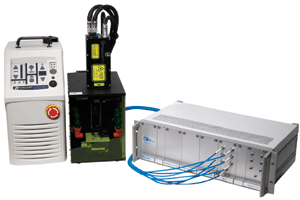|
Instrument Database:
Ocean Optics - LIBS 2000+
| |
|

|
| |
|
| |
|
| Year of introduction |
|
| Status |
available |
| Company |
Ocean Optics
|
| Categories |
Spectrometer ( Atom. ): AES: LIBS
|
The LIBS2000+ Laser-induced Breakdown Spectrometer is a detection system that permits real-time qualitative measurements of elements in solids, solutions and gases. This broadband, high-resolution system provides spectral analysis across a wide 200-980 nm range at a resolution of ~0.1 nm (FWHM).
Features
- Broadband, high-resolution spectral analysis (200-980 nm at 0.1 nm resolution)
- Real-time qualitative measurements
- Sensitivity to parts-per-billion and picogram levels is possible
- Applications include materials analysis, environmental monitoring, forensic and biomedical studies, art restoration and more
How the LIBS2000+ Works
A high-intensity, pulsed laser beam is focused on the sample area, positioned a few centimeters to a meter from the sample. A single 10 nanosecond-wide laser pulse is all that is needed to excite the sample. When the laser is fired, the high-temperature of the laser creates plasma. As the plasma decays or cools (~1.0 µsec after the laser pulse), excited atoms in the plasma emit light of characteristic wavelengths distinct to the element. All elements emit in the 200-980 nm region. The detection system uses seven of our HR2000 High-resolution Miniature Fiber Optic Spectrometers, each with a 2048-element linear CCD array. All spectrometers are triggered to acquire and read out data simultaneously. The detectors in the broadband (200-980 nm) LIBS2000+ collect the signal; software included with the system displays the data.
Advantages of Broadband LIBS Techniques
Most traditional LIBS detection systems have a small spectral range. The LIBS2000+ is the first to provide broadband spectral analysis. Because the system is noninvasive, users can perform real-time measurement in situ, within hostile industrial, chemical and biochemical environments -- with little or no sample preparation. Since the LIBS2000+ utilizes Ocean Optics HR2000 High-resolution Miniature Fiber Optic Spectrometers, the detection system is portable and can be interfaced to a notebook PC via a USB port.
Applications
The LIBS technique is useful for a variety of applications:
- Environmental monitoring (soil contamination, particulates)
- Materials analysis (metals, plastics)
- Forensics and biomedical studies (teeth, bones)
- Military and safety needs (explosive particles, chemical and biological warfare agents)
- Art restoration/conservation (pigments, precious/ancient metals)
Laser Needed for LIBS2000+
Users can supply their own laser for excitation or can purchase a laser through Ocean Optics. We recommend the ULTRA CFR Nd:YAG laser from Big Sky Laser Technologies. The ULTRA CFR was used when testing prototypes of the LIBS2000+. The rugged and field-portable ULTRA CFR delivers Q-switched pulses at 1.06 µm, with variable repetition rates from 1-20 Hz. At 1.06 µm, the laser has pulse stability of +/-3%.
Additional Features
The LIBS2000+ comes in a standard 3U rack case with handles for extra convenience. The LIBS2000+ is portable and operates with any 32-bit, USB-compatible Windows PC. The system interfaces to a PC via a USB port for easy plug-and-play use. We provide OOILIBS Application Software for operating the LIBS2000+ and for firing the laser. With OOILIBS software, the user has spectral-saving and data-logging capabilities. OOICOR Correlation Software -- developed with the University of Florida -- provides instant material identification when using the LIBS2000+.
LIBS Imaging Modules
The LIBS-IM and LIBS-IM-C Imaging Modules attach directly to the LIBS-SC Sample Chamber and enable users to magnify a sample image and to establish precisely a laser ablation target on the sample. Both modules are well suited to a variety of application areas that include forensics, semiconductor analysis, botany, biomedical analysis, gemology and metallurgy.
The imaging modules allow a user to see a magnified image of a sample via a CCD camera and PixeLINK, a Microsoft Windows-based image-capture software application. PixeLINK lets a user capture an image and archive it on the PC’s hard drive with detailed annotations. Captured images are useful for comparison analysis and application record keeping.
The CCD cameras used in the modules offer pixel resolution of 1280 x 1024. Each pixel is 6.0 µm x 6.0 µm square. The cameras provide frame rates of up to 12.7 frames-per-second at 1280 x 1024 resolution.
The LIBS-IM module produces black and white images with image resolution to 40 microns; the LIBS-IM-C provides color images at resolution to 60 microns.
Both modules connect to a PC or notebook via an IEEE 1394 (FireWire) cable and FireWire PCI (item LIBS-IM-PCI) or PCMCIA card (item LIBS-IM-PCIA). When attached to a PC, both modules are powered by the PC and require no external power; an external power supply is required when using the modules with a notebook computer. A power cable is included in the purchase price of each module.
|
| Specifications |
|
Spectrometer range: | 200-980 nm | Resolution: | 0.1 nm (FWHM) | Detection: | CCDs with a combined 14,336 pixels | Frame rate: | 10 Hz capability, computer-controlled | Integration time: | 2.1 ms; variable in free-run mode | Trigger delay: | -121 µs to +135 µs in 500 ns steps, computer-controlled | Trigger jitter: | +/-250 ns | Trigger level: | TTL not to exceed 5.5 V | Computer connection: | USB 1.1 (in all computers) | Software: | OOILIBS and OOICOR | Power requirement: | 5 volts @ <1 amp, power supply included | Input optical fiber: | 2 meter, multimode sampling probe with SMA connector and collimating lens | Size: | 84HP x 3U Rack Housing with handles (130 mm a 483 mm x 350 mm) | Certification: | CE |
|
|